It is probably best to expect the unexpected each day as a member of the hoofstock team at Fossil Rim, but at least generally in regard to the four seasons, experience helps the staff anticipate what lies ahead.
Before she began to work her way through a discussion of the seasons, Senior Animal Care Specialist Molly Shea mentioned the consistency of her morning routine throughout the year.
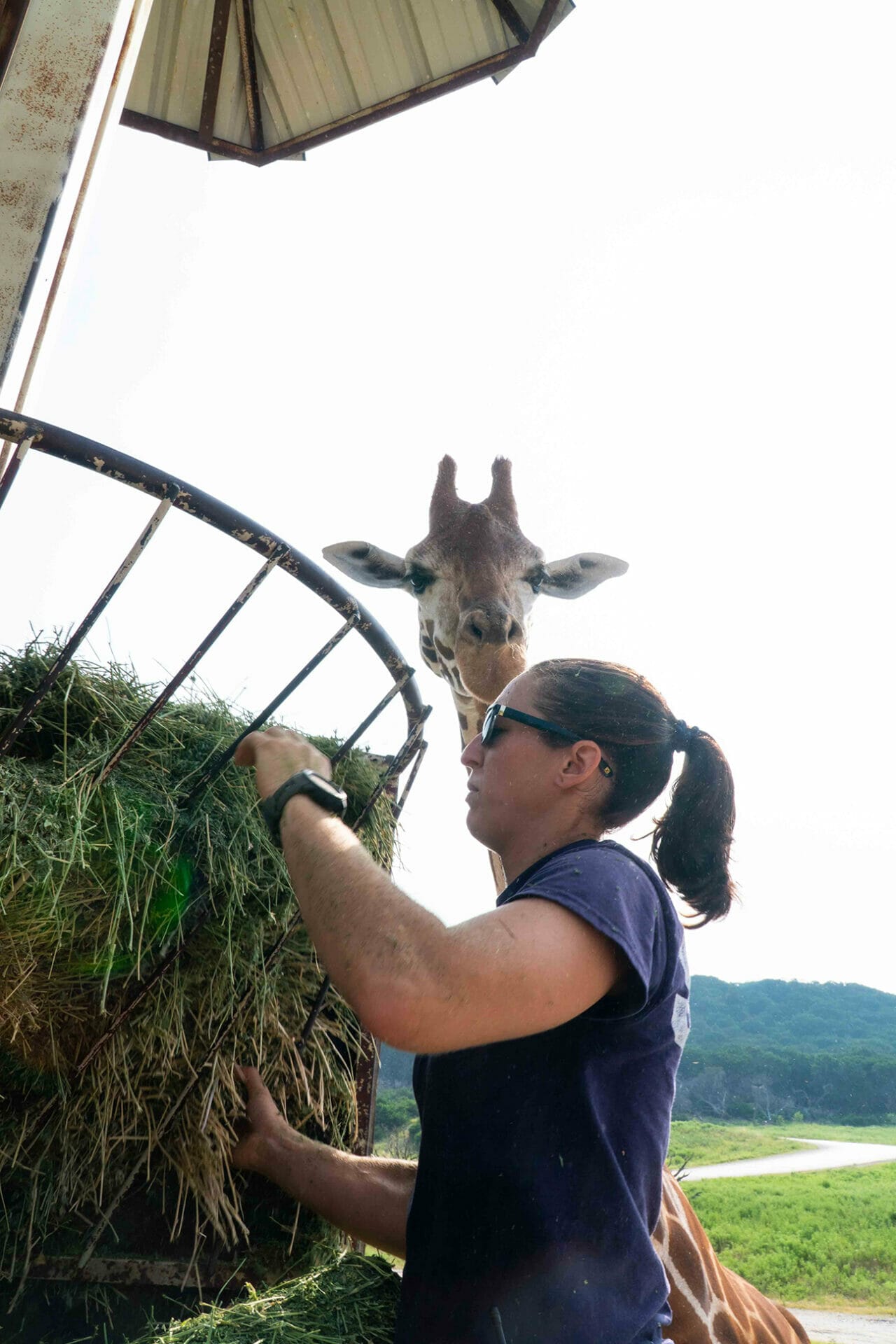
“After our morning animal care staff meeting, we collect our pellet feed and our hay before going out to feed our pastures,” she said. “That part is typically the same. The reason for that is we want to see our animals first thing in the morning to make sure that none of them need immediate help. Our animals are conditioned to be fed at the same time each morning, because that’s what we’ve done for 20-plus years.


“On Saturdays, we come in earlier because we tend to be busier, and the animals sometimes seem not quite ready for food. You will see some yawning out there. Also, right after a time change, you see the yawns or sense some impatience, depending on if we gained or lost an hour.”
While you may see just about all species eating in the mornings, the staff is targeting certain managed species to ensure they get fed.
We are only target feeding our managed antelope herds here,” she said. “Even so, when you drive through, you can tell the fallow deer are in very healthy body condition. That’s also the case with other species we aren’t targeting, as they can still graze and eat pellets provided by guests.”
Summer
What about summer mornings?
“We definitely work a bit faster during summer mornings because you know how hot it will be later in the day,” Shea said. “You want to get the most physically demanding stuff out of the way, not only for us – the animals get hot, too. The desert antelope are more conditioned to handle the heat than humans are.
“We did reproductive exams on a couple of black rhinos in June very early in the morning to avoid the summer heat. We would try to avoid a summer immobilization on an animal if possible.”
On that note, she pointed to the importance of being smart while working out in the heat.
“This is an obvious one, but as a staff we need to drink a lot more water,” she said of the summertime. “You check on each other, because you can’t last quite as long in the heat on some of these really intense days. When you get the chance, you try to find some shade under a tree.”
At least in past years, summer has been a time for the hoofstock staff to assist in the hay production process.

“Hay production is usually a key part of the summer,” she said. “This year, June and July were wetter and muddier than usual, which delayed our hay production and some of our other outdoor projects. Also, this year we outsourced the hay hauling, so the hoofstock staff wasn’t working on that. It has given us more time to catch up on other projects, such as cleaning out all the sheds in the pastures.
“During the winter, they are all lined with hay that the animals can snuggle into. There are 20 sheds spanning the four public pastures all with 6-8 inches of hay in them, so it’s a process to clean them out, but it’s important to prevent parasites the following winter. We bring the old hay to our compost area, as we also do with the rhino middens when we clean them.”

While parasites are a peak concern during the spring, Shea said they have been a bigger issue than usual this summer due to the wetter-than-average weather. There are various ways to combat that, and the hoofstock staff keeps a close eye on “parasite load” by collecting fecal samples that are tested by Veterinary Technician Allyssa Roberts.
On the other hand, if a summer is particularly dry, it can become essential to place water troughs out in the pastures in case the ponds, or “tanks,” get too low or dry up altogether.

Besides all the work they have to do for the animals, the hoofstock staff also needs to assist the security staff at times.
“Summer is particularly busy with guests, especially in terms of weekend traffic management,” Shea said. “It requires more time to make sure everyone is following the rules, which reduces the time available to work with the animals.”
Repairing fences as needed is an important summer activity. Intense spring winds may have knocked down trees that fell in the vicinity of fencing.
Fall
As the weather begins to cool, guest activity in the park is often reduced to some degree.
“Since school starts later in the summer, guest traffic is usually lower in the fall and we’re able to get more animal projects done,” Shea said. “There is always work to be done; it’s just a matter of your priority list.”
She discussed some of the projects that tend to get completed during autumn.
“Fall is usually about finishing up things we were trying to get done in the summer, but also about preparing for the winter,” she said. “We start lining sheds with hay as soon as temperatures begin to drop in October and generally make sure all sheds and barns are in good shape. The freezer flaps need to go up on the rhino barn in order to keep as much warm air in as possible. The giraffe barn will start to be used regularly, so any repair project needs to have been done in previous months.”
The age of the youngest giraffes can affect some fall decisions.
“For calves, the fall is possibly the first time they are going into the barn, so you want to catch them when it’s not critical,” she said. “Maybe try to bring them in for the first time on a mild fall evening. We need to make sure their propane heaters are filled and working properly, the barn door is opening and closing with ease, and the fences are in good condition.
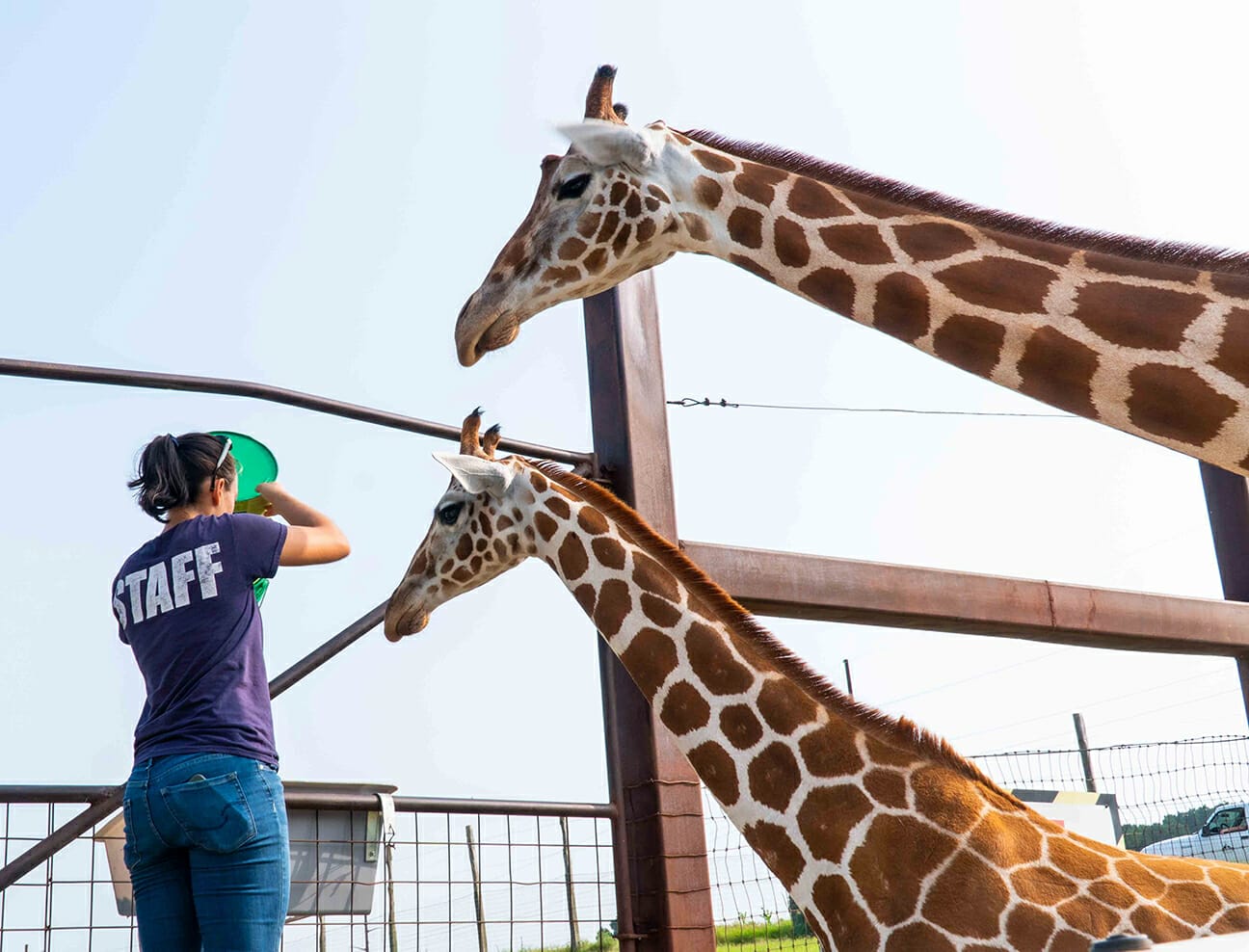
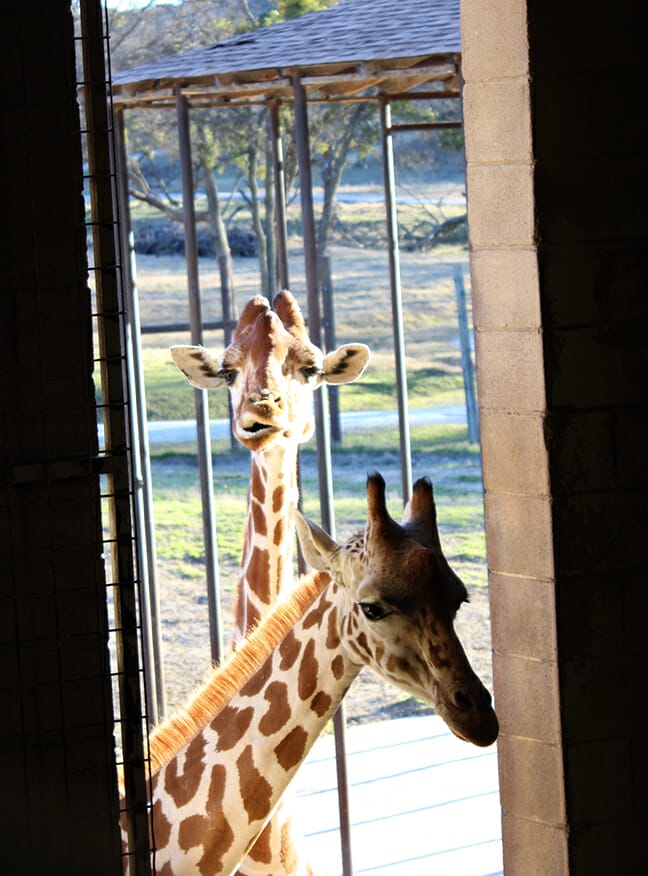
“The giraffes will go inside if it’s below 50 degrees. We might be more lenient if we just have older calves or adults, or maybe more sensitive if we have multiple young calves. Also, for lightning and thunder, or if we have a medical procedure to do, we’ll put them inside.”
As she referenced, the rhinos are the other large herbivores at Fossil Rim that go into a heated barn depending on the temperature.
“During the fall, we prepare the rhino barn for the winter,” Shea said. “We’ll bring them inside if we need to do maintenance in their yard.”
Pipes must be addressed before the freezing weather arrives.
“We need to make sure all of our pipes are freeze-proof before the temperature can drop enough to become a concern,” she said. “We survived the cold spell last winter because we were prepared for it. Being in good body condition with proper vitamin and mineral levels makes surviving harsh conditions less stressful.”
The hoofstock staff does some of its final bull switches for the year on managed herds during autumn, where intact males are swapped out for vasectomized bulls that still enable the herd to maintain normal behavior and hierarchy.
One of Fossil Rim’s most plentiful species, fallow deer are often the subject of fall medical procedures.
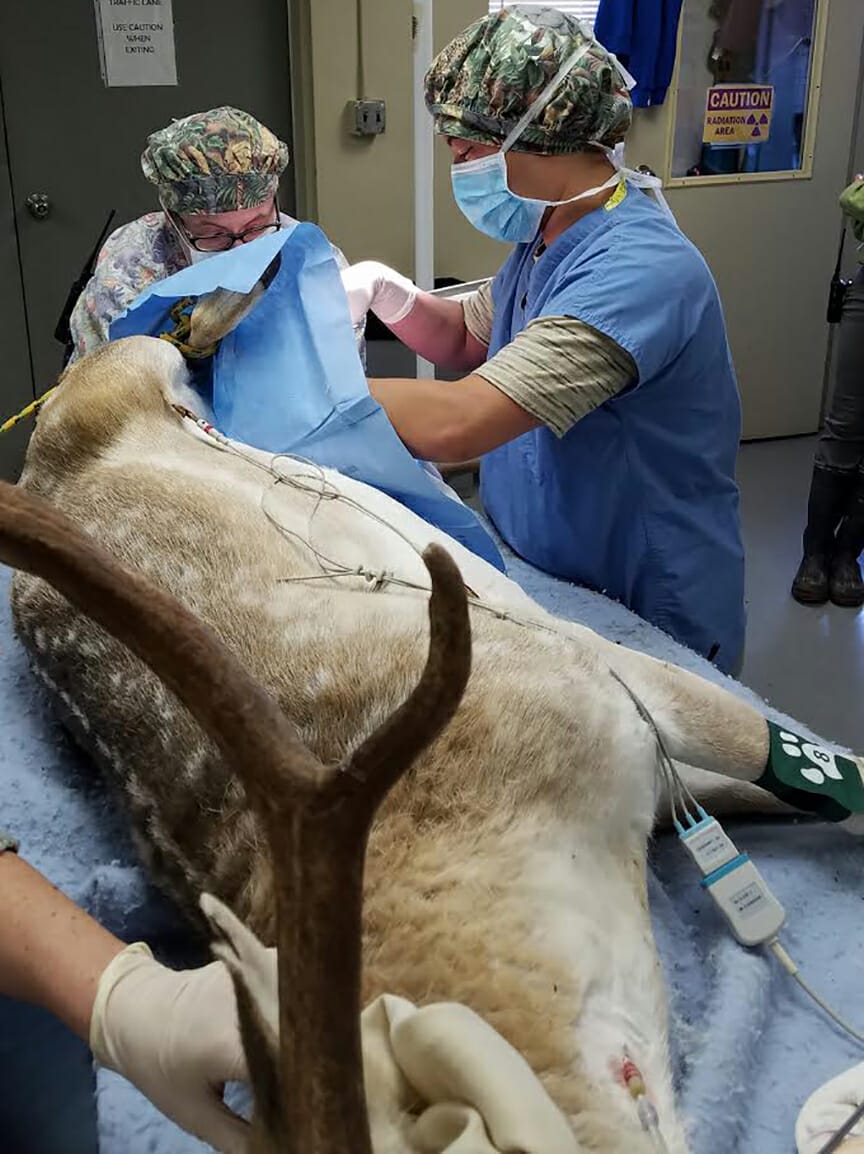
“When the fallow deer are in hard antler, that’s when we do any vasectomies or epididymectomies so that they become sterile, but still have their normal breeding behavior,” she said. “Doing the procedures that time of year does not disrupt their hormone production. Any male fallow deer tagged in its right ear means it has been epididymized or vasectomized, which is our preferred method of population management for this species.”
Winter
While some species like red deer and zebras handle the winter weather very well, others need special treatment.
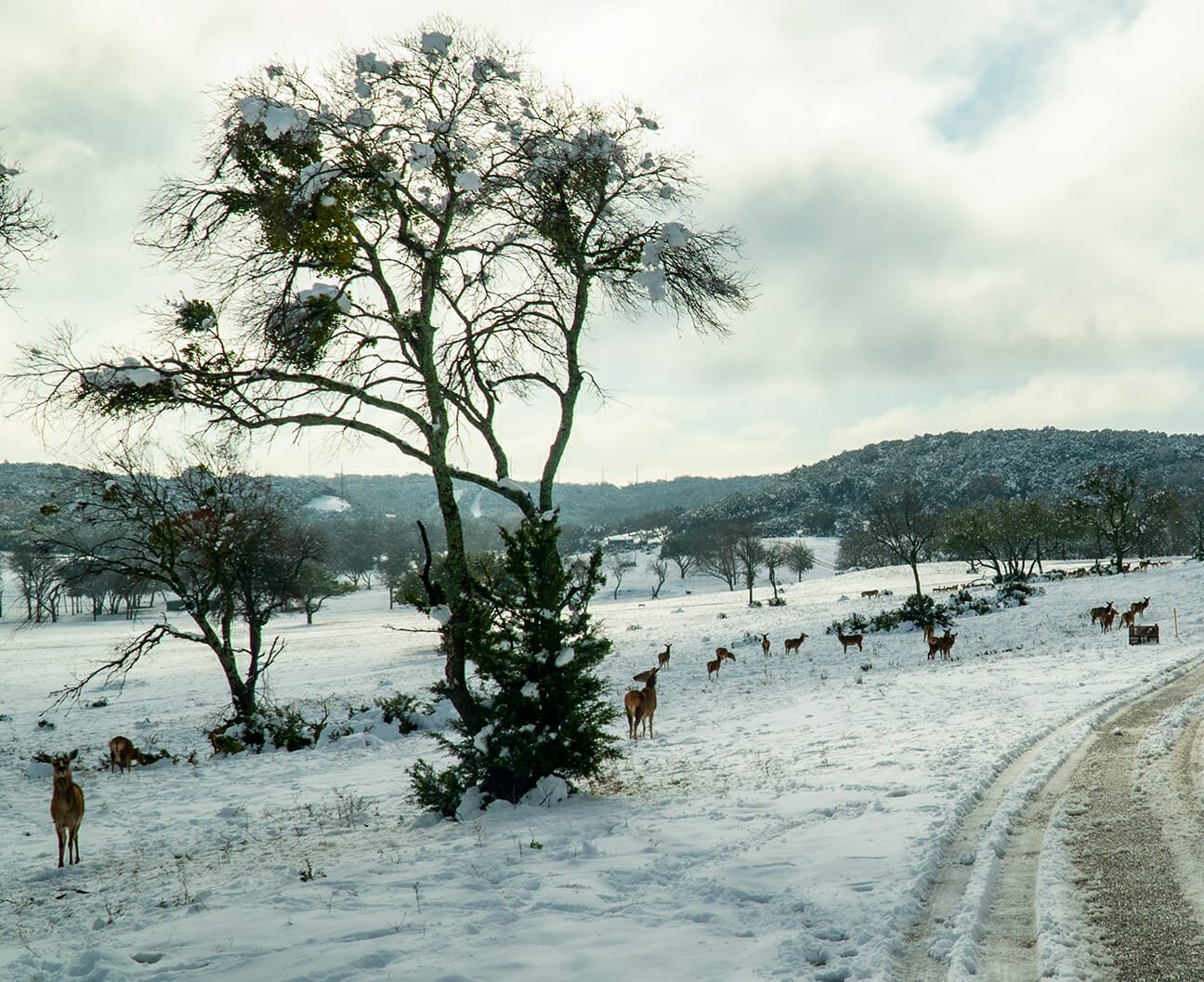
“In the Buffer Pasture, those species are a little more sensitive to the climate, dama gazelle most of all,” she said of the small, second pasture that guests enter. “Each one of their sheds are heated by propane, so our propane contractor comes out weekly and we take him around to make sure all the tanks are filled.”
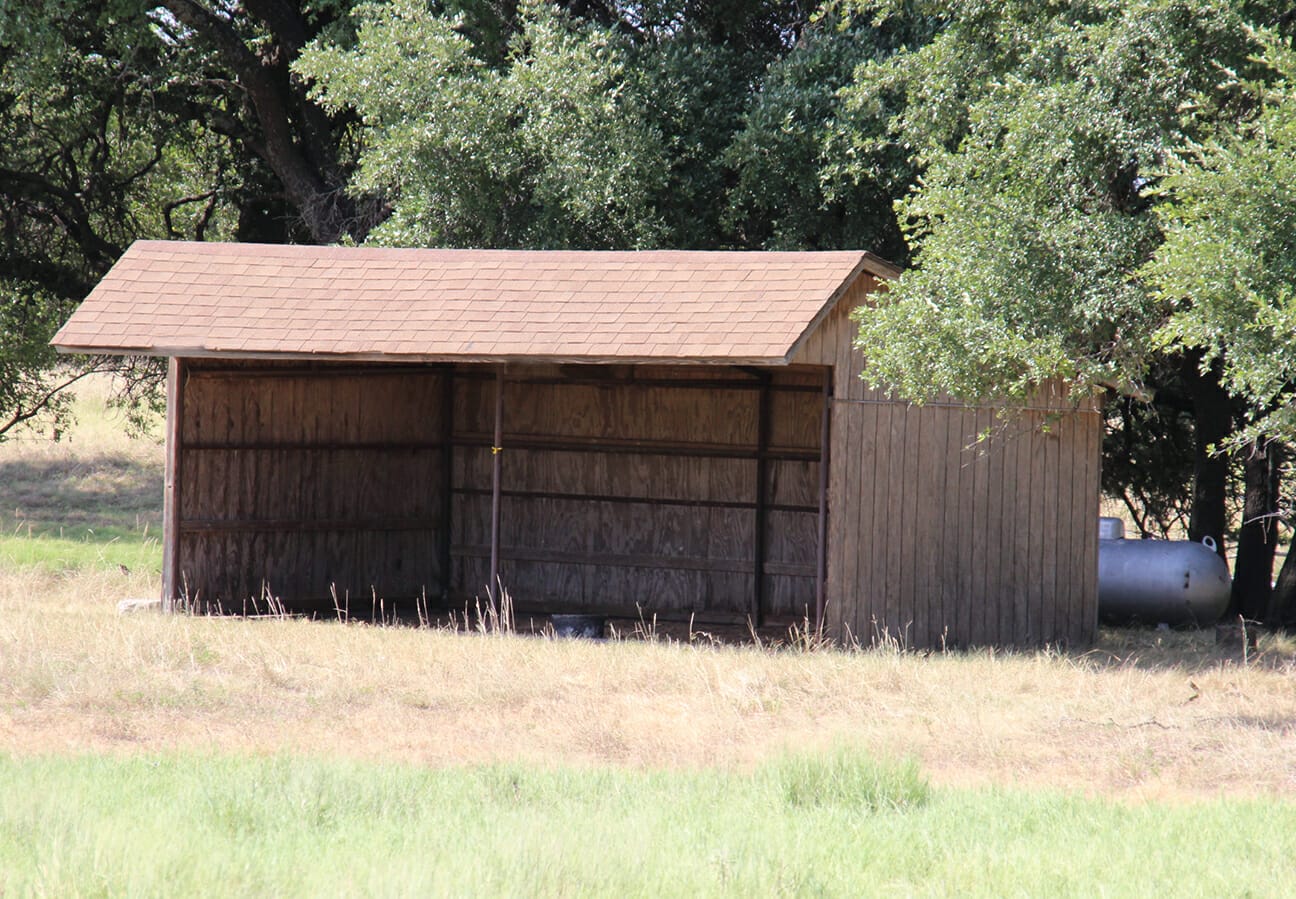
Animals staying outside adjacent to the vet clinic are monitored closely.
“We have to keep a close eye on any animals we’ve brought into the holding pens for medical care, because they are usually compromised,” she said. “They might be especially old, young, or thin, so you want to help them stay warm.”
She said, for the most part, animals in the pastures do not need much winter help other than the hay-lined sheds and round hay bales, since grass won’t be available in winter.
Like summer, this is a season when staff is very careful about the timing of its immobilization procedures.
“We have to consider the conditions and maybe wait for a better day for immobilizations and other animal procedures to avoid extreme temperatures,” she said. “While we target early morning in the summer, in winter it is often better to wait until the afternoon to do a procedure when it is warmer.”
She also referenced trimming trees during the winter.
“You can only trim oaks responsibly in the winter months, otherwise oak wilt can spread,” she said. “We don’t trim until we’ve had 1-2 freezes. We avoid trimming other trees without leaves in the winter. If we are going to trim a tree, we might as well wait until it has leaves so we can feed it to our browsers and maximize resources.”
Much discussion in the fall section of this article was about preparing for the worst winter has to offer, and Fossil Rim certainly got that in 2021. The temperature stayed below freezing from 6 p.m. on February 13 until 6 a.m. on February 19 with a low of -5 degrees.
“When I referenced that most of our animals only need hay-lined sheds and hay to eat in the winter, the extreme freeze this year was a totally different story,” she said. “It was like nothing any of us had ever dealt with here before. Everyone was going through their own issues at home; some staff didn’t have heat or electricity or both, maybe they didn’t have water. Honestly, I’d rather be at work than sitting at home in the dark.
“Everybody came together and did what had to be done. Our executive director was out here breaking ice so the animals could drink fresh water. Our vet team was riding with the animal care department, helping us get hay and (pellet) feed into sheds.
“We wanted the animals to have access to food without leaving the warmth of the shed. It was a crazy time; we went through about three months’ worth of hay in eight days or so. We brought 3-5 square bales into each shed twice a day.
“We had to purchase some bales this year after going through so much that quickly. Also, we fed almost twice as much pellet feed as normal during that span with afternoon feedings in addition to the morning routine.”
As it turned out, the extra feedings were crucial for the animals’ heat generation.
“While most hoofstock will have a thicker winter coat, they don’t have additional means of warmth during these extreme storms besides huddling together,” she said. “But, what you can do is make sure their four-chambered stomach stays full and busy digesting, which generates warmth from the inside out.”
Shea said persevering through the prolonged freeze showed a lot about the staff’s commitment.
“That was definitely the most unique situation for our staff,” she said. “Only a handful of us could work every day due to road conditions; I rode with (Associate Veterinarian Dr.) Julie (Swenson) because she has four-wheel drive.
“It was a challenge and we were in it together for the sake of the animals. We all knew what was at stake for Fossil Rim.”
Spring
As referenced in the summer section, parasites – both monitoring for and combating them – are usually a springtime staple of staff activities.
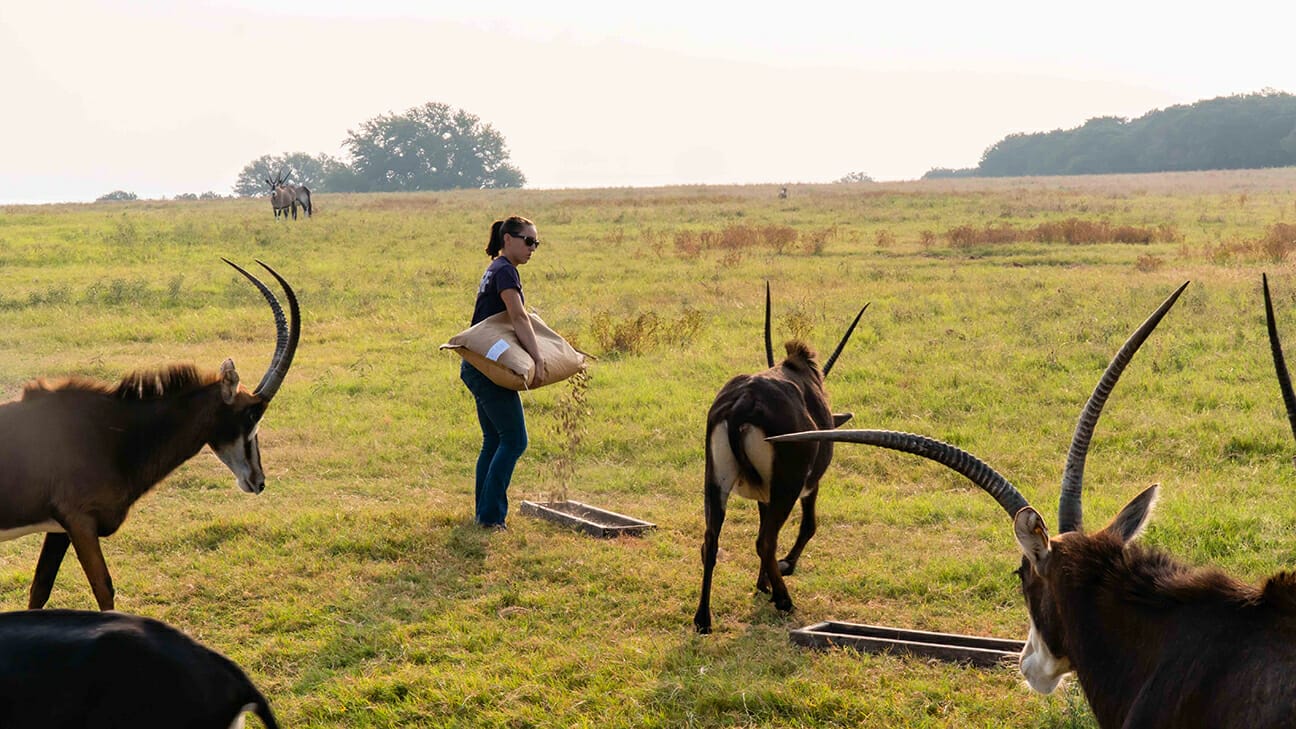
“The February freeze did give us about a month of peace from parasites, but then we were hit with a particularly wet spring and summer,” Shea said. “Over a three-week span, we immobilized a large number of animals, plus collected fecal samples on almost every herd to manage their parasite loads.

“In order to do this, we had to identify each animal, collect a fecal sample, bring it to the clinic, and Allyssa had to test each one and log all the results. If the results showed that an animal needed treatment, we had to make a plan to treat each individual. It’s a lot of work, but we’ve come to expect to deal with parasites in the spring.”
As guests are well aware, baby animals are a big part of the spring experience, as well.
“You know the spring is going to be chaotic with all of the new births, so we plan accordingly,” Shea said. “Expect early mornings and late nights around here. The Main Pasture is 400-plus acres with a lot of wooded areas, so it can be hard to find an animal that doesn’t want to be found. Sometimes, the best bet is to come in when the sun is coming up or going down to catch mothers nursing their newborn calves.
“Fortunately, we get a lot of the neonate exams done during the workday, but if your midday calf runs are unsuccessful, you should have better luck in the early or late hours. We plan for most of our calves to be born in the spring, but occasionally that spills over into the summer, as well.”
Addax are usually one of the easier species to encounter on your visit, but not always.
“In the late spring, you won’t see as many addax coming up because the females are off in various parts of the pasture with their calves,” Shea said. “Right before calving, that’s probably the biggest the addax herd will be and we are feeding more to accommodate them. But, as spring grass comes up and grazing opportunities increase, the need for pellets decreases; it is constantly fluctuating.”
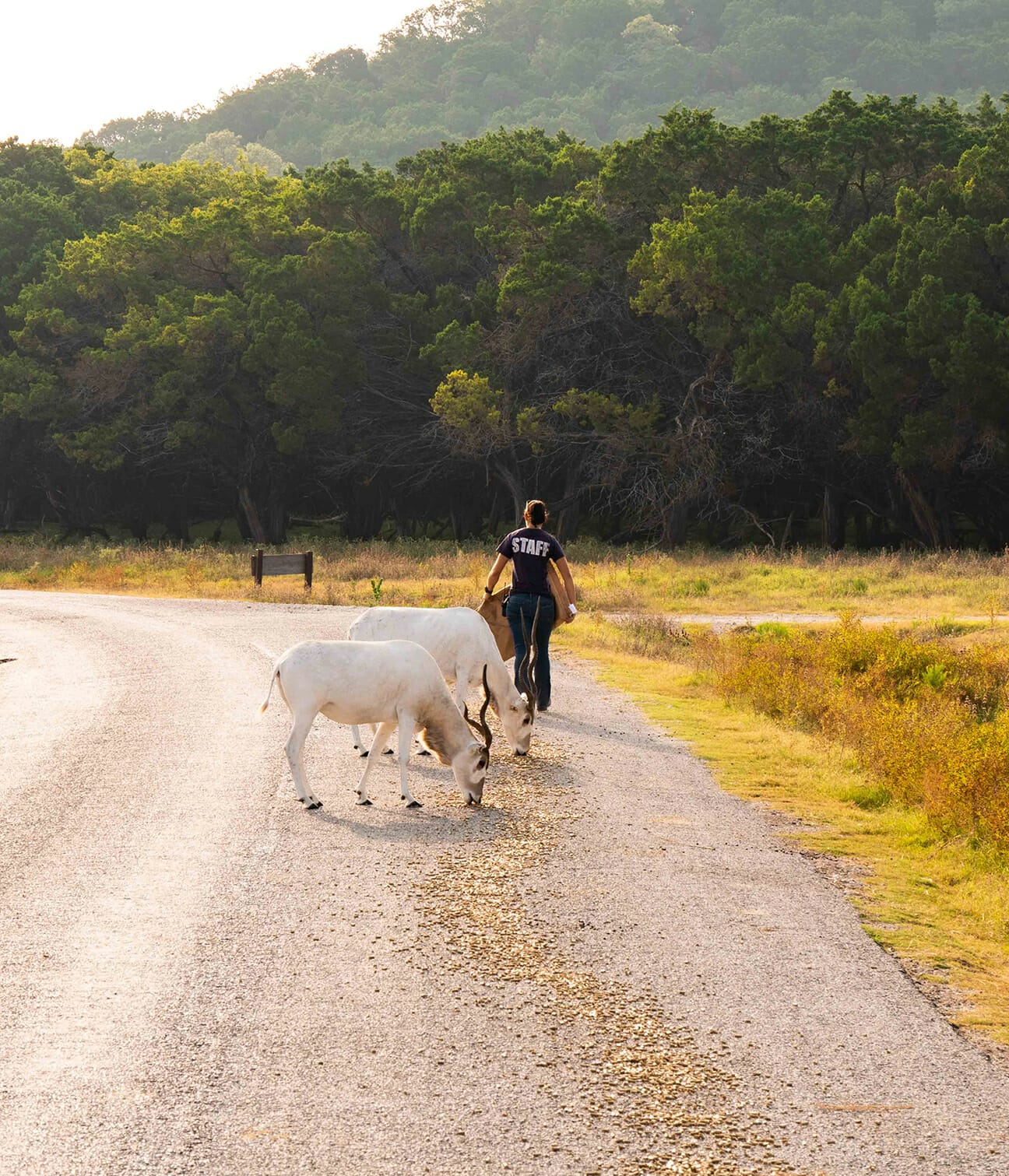

Overall, the staff does not offer as much food to the animals during the spring as it did during the winter, as green grasses are providing great grazing opportunities. Helping maximize those grazing opportunities is part of the job.
“We will do some shredding in the spring and summer of certain areas and certain plants like thistle and nightshade before they seed out,” she said. “You might look at the pastures and think ‘there’s so much green,’ but the animals won’t actually eat a lot of that vegetation. It’s the grass growing beneath everything that we want them to eat.”
While it is grass that many of the hoofstock species seek, spotting some antlers on the ground can literally pay off for the staff.
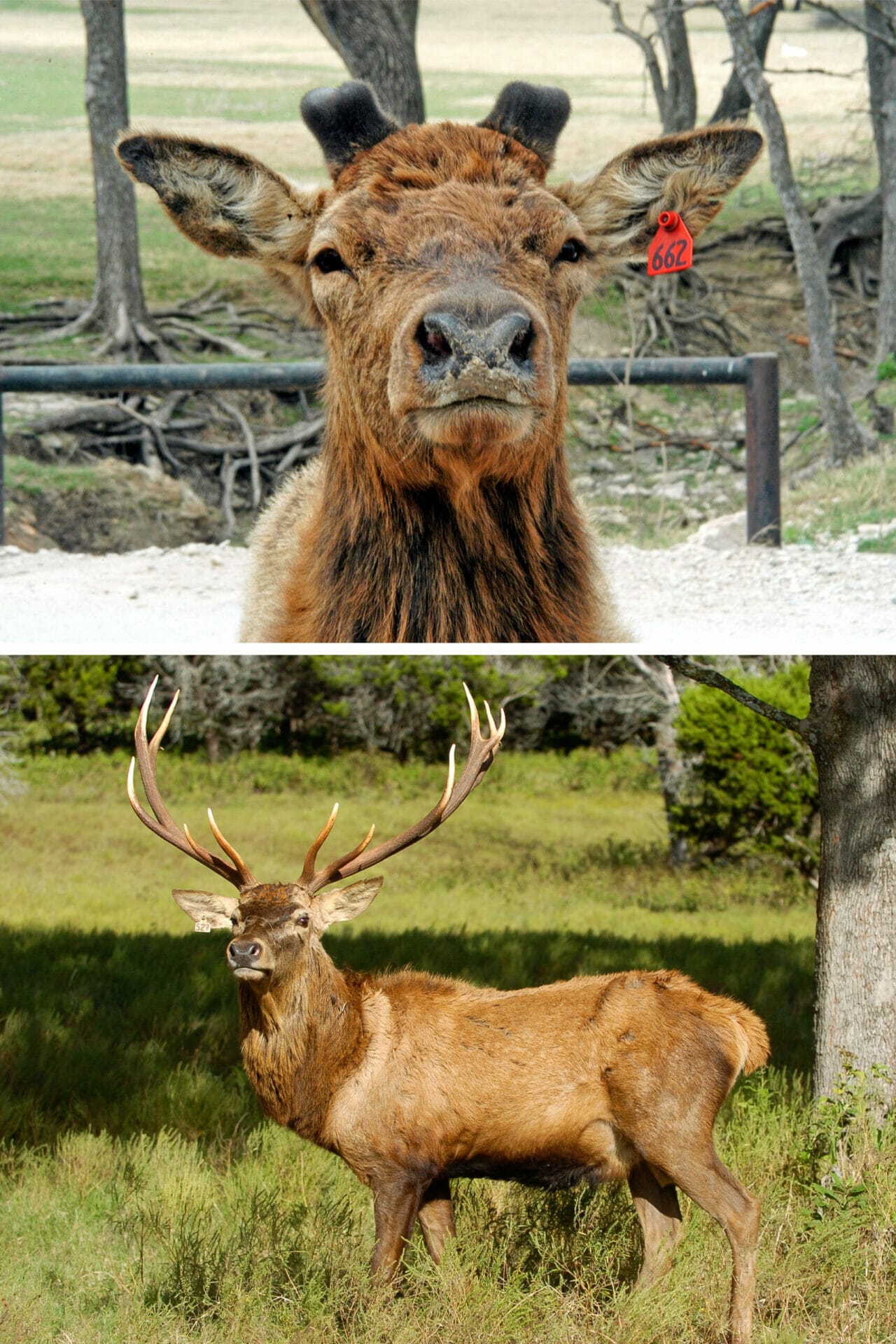
“Deer are dropping their antlers in the spring months,” Shea said. “Animal care collects them and brings them to the Nature Store. When guests buy them, it’s a direct source of funding for animal care.”
Season Selection
Shea was asked if she had advice for guests who were considering what time of year they should visit Fossil Rim.
“I always recommend that people visit on a gloomy weekday morning,” she said. “I say that because the park won’t be nearly as busy as the weekends. I think you can find something special any month of the year that you come out here; it just depends on what you’re looking for.
“In the fall and winter, afternoons can still be a good time to visit because animals will be basking in the sun. If you were able to visit the animals after the snow storms, that was its own unique opportunity. In the spring and summer, you may catch a glimpse of newborn calves or see older calves that have recently joined their herds.
“There are pros and cons for each season, but those weekday mornings will have maximum animal activity.”
-Tye Chandler, Marketing Associate

Very interesting and informative! So much physical work goes into keeping those animals healthy and fed. After reading this I can appreciate the knowledge it takes to maintain their habitat and their well being.
Thanks, I’m going to assume you may know Molly. 😉
She really cares about these animals. You can tell.
I am amazed at the hard work and dedication of Molly and other staff. I can’t wait to visit Fossil Rim the next time I am in Texas! Way to go Molly!